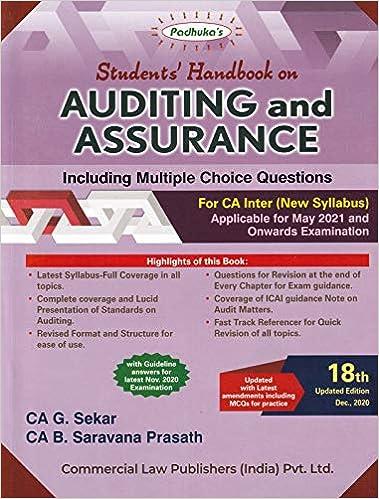Question
1. How is control determined when a parent company does not own a majority of the voting stock of a subsidiary? Multiple Choice Top of
1.
How is control determined when a parent company does not own a majority of the voting stock of a subsidiary?
Multiple Choice
Top of Form
Controlling the subsidiarys financing activities.
Controlling the subsidiarys investing activities.
Criteria that establish effective control include control of the subsidiarys senior management or board of directors, the control of the subsidiarys operating, investing, or financing activities, and the right to obtain control by buying more shares after a triggering event.
Controlling the subsidiarys operating activities.
2.
How does accounting for bearer plants differ from that for other biological assets?
Multiple Choice
Companies never revalue bearer plants, because of their nature.
Companies treat bearer plants as PPE. Thus, they choose between the cost and revaluation models for these assets. The treatment of bearer plants constitutes an important exception to the requirement that companies revalue biological assets.
Companies always revalue bearer plants, as they are required to do for all other biological assets.
Companies treat bearer plants as goodwill.
3.
Under U.S. GAAP, fixed assets are generally reported on the balance sheet at their:
Multiple Choice
fair value.
historical cost.
market value.
net realizable value.
4.
Which intangible assets are subject to annual impairment testing?
Multiple Choice
Indefinite-lived intangible assets.
Definite-lived tangible assets.
Definite-lived intangible assets.
Indefinite-lived intangibles and goodwill are subject to impairment testing at least annually.
5.
How do IFRS and U.S. GAAP differ in their approach to allowing reversals of inventory write-downs?
Multiple Choice
IFRS requires the reversal of write-downs from cost to net realization value (NRV) when the selling price increases. U.S. GAAP prohibits the reversal of past write-downs.
The cost of the intangibles should be expensed by the acquiring company on the merger date.
If they had not been previously recorded as separate assets by the acquired company, they should always be recorded as "Goodwill" on the balance sheet of the company acquiring them.
They should be recorded as separate intangible assets only if their useful life is indefinite.
Step by Step Solution
There are 3 Steps involved in it
Step: 1

Get Instant Access to Expert-Tailored Solutions
See step-by-step solutions with expert insights and AI powered tools for academic success
Step: 2

Step: 3

Ace Your Homework with AI
Get the answers you need in no time with our AI-driven, step-by-step assistance
Get Started


